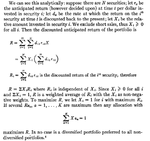Thanks for the concise post and the respectful tone. I will reply as I read.
I will forgive you, because in fact this has been mentioned by bbmac, or at least it was a similar suggestion. And I've already replied to him, but I'll do it again and maybe I'll reply even more thoroughly and/or clearly this time.
He asked: given that your equity line is the product of 11 different combinations of systems and 4 different levels of capital invested (15k, 30k, 40k, 160k), shouldn't you draw it in a way to reflect all these changes?
As a consequence of his remark, after a few weeks, I added some information (capital invested) on my equity line:

So, by all means, yours and his are not irrelevant observations. But the problem is that in everything, you can see things from many perspectives, and none of them is perfect. No chart will ever represent every aspect of your situation. So you have to simplify.
That is unless you want me to go crazy and burn out by creating 7 workbooks and over 100 sheets like the investors did.
But then synthesis goes down the ****ing toilet.
Anyway, as far as using one chart (because we cannot afford more than one chart or I'll go crazy and/or burn out), the clearest and most coherent synthesis is absolute profit, with the addition of capital invested (mostly for the readers, because it was pretty clear in my own mind how much capital was being invested at any given time).
If someone asks me what that chart is, I will simply reply that it is "profit by my systems". And if they ask what those little dots are, then I'll reply "every dot is a trade".
If I get started changing things according to your or bbmac's suggestions, and someone asks me what my chart represents, then I'll have problems replying as concisely and clearly, because the chart will become a ****ing mess.
First of all, I don't know even know how we should go about representing properly the 11 different combinations of profit and 4 different amounts of capital invested. Second of all, if it ever becomes clear... it will still never be as clear and as representative as an equity line simply showing profit.
It's just like for moving averages. I could use exponential bull****, but I always use the simple moving averages.
Some brainstorming on the difficulties and problems of changing that equity line:
1) what do we do? we take weekly profit and divide it by margin used? That changed every single hour: impossible to do
2) if we change anything in that chart, we lose the information of the precise amount made and lost by each trade: very precious information indeed. Merely losing that kind of information makes the whole suggestion of yours not worth following.
3) do we divide profit made by capital available? But we didn't even use all of it. We should do margin, but then it changes all the time, so what the **** do we do? It doesn't make any sense.
4) many more problems.
5) more problems.
6) another problem here.
There's times when you need to get rid of all bull**** and be synthetic. And I am good at that. And when you interfere with that, things go wrong. They don't even go any further, because you die, suffocated by workbooks, and worksheets, and rows, and columns.
But keep on giving me advice, because sometimes I get some good ideas from the readers. The last one was by weighbridge, in October 2009. He helped me with the max drawdown formula on excel:
http://www.trade2win.com/boards/trading-journals/72598-my-journal-44.html#post953574
Just kidding, there's been some more after Weighbridge, but that was the first good idea I got from a reader and he remained in my heart. That son of a bitch. He's not even reading my journal anymore. Mother ****er. I think he may have gotten offended by the language I use. But this is my normal language, as I learned English from some young criminals in a boarding school, and "mother ****er" was like an affectionate term. "**** sucker" is similar to calling someone "honey" or "darling". Not really. It's rather a form of saying to a person that you respect him.
But some people don't understand such nuances, and they get offended. That doesn't make any sense.






